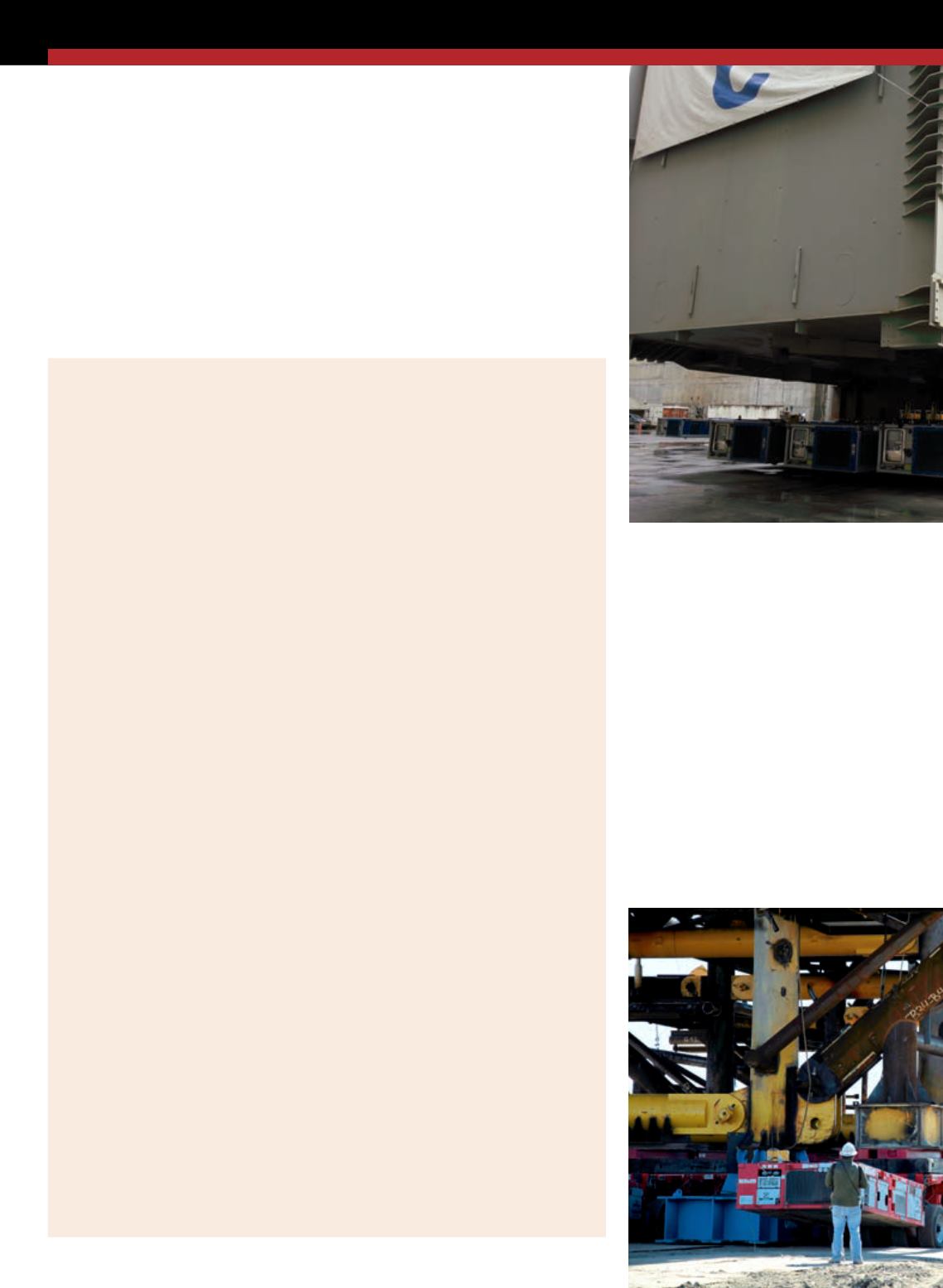
50
ACT
APRIL 2015
PRODUCT FOCUS
SPMTS
PowerMAX and theSPMCPowerMAX.
TheAPMChas threemodes, trailer,
assist andSPMT,while theSPMC ismore
of a classic self-propelledunit. TheSPMC
system is basedon auser-friendly system
that includes a customizable remote. Each
operator canmonitor thedata that ismost
important to themby configuring the
remote theway they see fit.
The newcomer
Enerpac entered theSPMTmarket
about sevenyears ago to fill aneed in the
industry for compact SPMTs capableof
maneuvering in tight locations. Enerpac
SPMTshavebeen soldglobally and
arebeingused inbothdeveloped and
emergingmarkets. They currentlyhave
SPMTs inNorthAmerica, TheMiddle
East,Africa andEurope.
“SPMTs are such aversatile tool and
asheavy lifting and transport projects
becomemore complex, new applications
are always evolving,” saidTony Johnson,
integrated solutionsproductmanager,
Enerpac. “For example asAccelerated
BridgeConstruction (ABC) has gained in
popularity sohas theuseof SPMTs.”
TheEnerpacSPMT features a
minimizedheight and slimdesign,which
makes it easy tooperate in confined spaces
andmakes it agood solution for in-plant
applications. Enerpac’s SPMT customers
come from avarietyofmarkets including
oil&gas, power generation, infrastructure
andmanufacturing.
They recentlyupdated their Intelli-Drive
wireless control system tooffer greater
flexibilitywhen customizingSPMT
configurations, aswell asupgraded the
SPMT tomeet strict standards foruse in
nuclearpowerplants.
AlthoughEnerpac isheadquartered
inNorthAmerica, theirprimary
manufacturing facility for building
Cometto’sMSPE EVO2
60T SPMT is involved
in the Panama Canal
expansion project.
The story goes like this
Importing self-propelledmodular transporters (SPMTs) into North America hasn’t always
been a breeze. There are Customs rulings on SPMTs going back to the early 1990s.
Initially, they were classified under the heading 8709 (the first four digits of the Customs
code), the same heading as work trucks, or trucks that are not fitted with lifting or
handling equipment. As such, SPMTs were duty-free.
In the late 1990s, Canadian importers brought forth an inquiry regarding the 8709
heading to theWorld Customs Organization (WCO), specifically the bit about not being
fitted with lifting or handling equipment. SPMTs actually are fitted with lifting equipment,
and when theWCO revisited the topic they reclassified SPMTs under a new heading
labeled 8427. This is the same heading used for things like fork lifts and other trucks
fitted with lifting equipment.
SPMTs remained under the 8427 heading until 2011when once again their status was
revisited by theWCO. This time around, theWCO came to the conclusion that SPMTs
were designed tomove heavy things from one place to another, and therefore should be
under the 8704 heading, formotor vehicles for the transport of goods. Unfortunately for
anyone trying to import an SPMT, this new heading brought with it a 25 percent Customs
duty.
“This posed a particular problem because Customs is supposed to give the public
a period of notice when they change the classification of these things,” saidMichael
Snarr, attorney and partner at BakerHostetler inWashington D.C. “This came as a huge
surprise to themembers of the SC&RA. Suddenly you’ve got a small business that’s
trying to pay a $1million Customs duty on the spot without any notice it wasn’t going to
happen.”
Snarr approached Customs on behalf of his client, an SC&RAmember, to challenge the
classification of SPMTs in U.S. ports. “We told them they didn’t have the classification
right and in addition, you’re required by law to give public notice on a change in
classification,” he said.
Once Snarr and the SC&RA raised these issues, Customs basically told them they
weren’t sure what the heading for SPMTs should be but they definitely didn’t give the
proper notice for the change. For the time being they would revert back to the old, duty-
free heading until a decision could bemade.
“So I worked with Joel [Dandrea] and we got somemembers together and went to
customs to explainwhy these things aren’tmotor vehicles,” said Snarr. “We showed them
a video of how SPMTs work and I think at that meeting they really sawwhat we were
talking about.”
So two and a half years later on Feb. 4, 2015, after all the litigation, research and
rumination, Customs issued a document that spelled out their final decision. The way they
saw it, SPMTs belonged under heading 8427, the same duty-free heading as forklifts that
they were classified under for almost a decade between the late 1990s and late 2000s.
“At a time when the country was still trying to shake off some of the economic recovery
problems, it was hard to understand why the government would put this 25 percent
tax on thesemachines,” said Snarr. “The SC&RA is a lot of small business, so if you’re
supporting small businesses as the backbone of the economy, you had to get this right.”
And they did. For now.
Goldhofer’s PST/ES/E.


